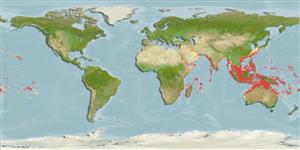>
Eupercaria/misc (Various families in series Eupercaria) >
Lutjanidae (Snappers) > Lutjaninae
Etymology: Lutjanus: Malay, ikan lutjan, name of a fish.
More on author: Forsskål.
Environment: milieu / climate zone / depth range / distribution range
экология
морской ассоциированный с рифами; пределы глубины 1 - 150 m (Ref. 9710). Tropical; 35°N - 33°S, 31°E - 134°W (Ref. 55)
Indo-Pacific: Red Sea and East Africa to the Line and Society islands, north to southern Japan, south to Australia.
Length at first maturity / Size / Вес / Возраст
Maturity: Lm 21.5 range ? - ? cm
Max length : 56.8 cm FL самец/пол неопределен; (Ref. 125599); common length : 45.0 cm TL самец/пол неопределен; (Ref. 5450); наибольший вес (опубликованные данные): 2.8 kg (Ref. 125599); наибольший возраст (опубликованны данные): 18 годы (Ref. 2293)
колючие лучи спинного плавника (общее число): 10; членистые (мягкие) лучи спинного плавника (общее число): 13-14; колючие лучи анального плавника 3; членистые (мягкие) лучи анального плавника: 8. This species is distinguished by the following characters: body moderately deep; greatest depth 2.2-2.5 in SL; preopercular notch and knob well developed; vomerine tooth patch crescentic, without a medial posterior extension; gill rakers of first gill arch 9-10 + 115-20 = 25-30 (including rudiments); caudal fin distinctly forked with rounded lobes. Colour red to greyish, an orange hue on lower part of opercle and in pectoral fin axil; fins red (pectoral fins) or usually dark brown to blackish; soft part of dorsal fin, anal and caudal fins with a narrow white margin; juveniles with a large round black spot at base of caudal fin (Ref. 9821, 90102).
Adults mainly inhabit coral reefs, sometimes forming large aggregations, which are mostly stationary during the day. Juveniles occur in seagrass beds, also in mixed sand and coral habitats of shallow sheltered reefs (Ref. 1602). Sub-adults commonly form very large schools that are stationary or drift slowly along slopes during the day. Large individuals along coastal slopes at moderate depths (Ref. 48635). Benthopelagic (Ref. 58302). Feed on fishes, and a variety of invertebrates including shrimps, crabs, lobsters, stomatopods, cephalopods, echinoderms and ophiuroids (Ref. 55). Caught mainly with handlines, traps, and gill nets. Commonly sold fresh. Sometimes causes ciguatera poisoning, particularly around the Pacific islands (Ref. 9821).
Off East Africa spawning occurs mainly during spring and summer.
Allen, G.R., 1985. FAO Species Catalogue. Vol. 6. Snappers of the world. An annotated and illustrated catalogue of lutjanid species known to date. FAO Fish. Synop. 125(6):208 p. Rome: FAO. (Ref. 55)
Статус Красного Списка МСОП (Ref. 130435)
Угроза для людей
Reports of ciguatera poisoning (Ref. 9710)
Использование человеком
рыболовство: коммерческий; объект спортивного рыболовства: да; аквариум: общественные аквариумы
дополнительная информация
ссылкиаквакультура (рыбоводство)особенности рыбоводствастепень растяжениягенетикаElectrophoresesнаследуемостьболезниобработкаNutrientsMass conversion
инструменты
Специальные отчеты
Скачать в формате XML
ресурсы в Интернет
Estimates based on models
Preferred temperature (Ref.
123201): 24.5 - 29.1, mean 28 °C (based on 2228 cells).
Phylogenetic diversity index (Ref.
82804): PD
50 = 0.5000 [Uniqueness, from 0.5 = low to 2.0 = high].
Bayesian length-weight: a=0.01549 (0.01389 - 0.01727), b=2.97 (2.95 - 2.99), in cm total length, based on LWR estimates for this species (Ref.
93245).
Trophic level (Ref.
69278): 4.1 ±0.3 se; based on diet studies.
устойчивость к внешним воздействиям (Ref.
120179): средний (среднего размера), минимальное время удвоения популяции 1.4-4.4 года (K=0.31-0.40; tmax=18).
Prior r = 0.57, 95% CL = 0.37 - 0.85, Based on 1 stock assessment.
Fishing Vulnerability (Ref.
59153): Moderate vulnerability (36 of 100).
Climate Vulnerability (Ref.
125649): High vulnerability (63 of 100).
Nutrients (Ref.
124155): Calcium = 31.8 [20.8, 43.7] mg/100g; Iron = 0.323 [0.211, 0.482] mg/100g; Protein = 18.6 [17.1, 19.9] %; Omega3 = 0.148 [0.108, 0.199] g/100g; Selenium = 72.2 [50.0, 100.4] μg/100g; VitaminA = 137 [26, 492] μg/100g; Zinc = 0.406 [0.333, 0.555] mg/100g (wet weight); based on
nutrient studies.
